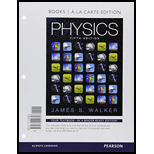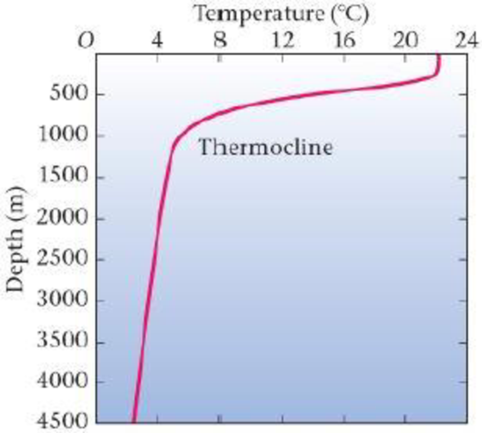
Concept explainers
Energy from the Ocean
Whenever two objects are at different temperatures, thermal energy can be extracted with a

Figure 18-37 Temperature versus depth for ocean waters in the tropics (Problems 93, 94, 95. and 96)
The idea of tapping this potential source of energy has been around for a long time. In 1870, for example, Captain Nemo in Jules Verne’s Twenty Thousand Leagues Under the Sea, said, “I owe all to the ocean; it produces electricity, and electricity gives heat, light, motion, and, in a word, life to the Nautilus.” Just 11 years later, the French physicist Jacques Arsene d’Arsonval proposed a practical system referred to as Ocean Thermal Energy Conversion (OTEC), and in 1930 Georges Claude, one of d’Arsonval’s students, built and operated the first experimental OTEC system off the coast of Cuba.
OTEC systems which are potentially low-cost and carbon neutral, can provide not only electricity, but also desalinated water as part of the process. In fact, an OTEC plant generating 2 MW of electricity is expected to produce over 14,000 cubic feet of desalinated water a day. The governments of Hawaii, Japan, and Australia are actively pursuing plans for OTEC systems.
94. • If we could go deeper for colder water, say to a depth of 4500 m, what is the maximum efficiency that can be achieved?
- A. 6.64%
- B. 7.52%
- C. 14.0%
- D. 25.5%
Want to see the full answer?
Check out a sample textbook solution
Chapter 18 Solutions
Physics, Books a la Carte Plus Mastering Physics with Pearson eText -- Access Card Package (5th Edition)
Additional Science Textbook Solutions
Physics for Scientists and Engineers: A Strategic Approach, Vol. 1 (Chs 1-21) (4th Edition)
Microbiology with Diseases by Body System (5th Edition)
Campbell Biology (11th Edition)
Microbiology: An Introduction
Chemistry: An Introduction to General, Organic, and Biological Chemistry (13th Edition)
Campbell Essential Biology (7th Edition)
- What is the resistance (in (2) of a 27.5 m long piece of 17 gauge copper wire having a 1.150 mm diameter? 0.445 ΧΩarrow_forwardFind the ratio of the diameter of silver to iron wire, if they have the same resistance per unit length (as they might in household wiring). d. Ag dFe = 2.47 ×arrow_forwardFind the ratio of the diameter of silver to iron wire, if they have the same resistance per unit length (as they might in household wiring). d Ag = 2.51 dFe ×arrow_forward
- Show that the units 1 v2/Q = 1 W, as implied by the equation P = V²/R. Starting with the equation P = V²/R, we can get an expression for a watt in terms of voltage and resistance. The units for voltage, V, are equivalent to [? v2 v2 A, are equivalent to J/C ✓ X . Therefore, 1 = 1 = 1 A V1 J/s Ω V-A X = 1 W. . The units for resistance, Q, are equivalent to ? The units for current,arrow_forwardPlease solve and answer the question correctly please. Thank you!!arrow_forwardPlease solve and answer the question correctly please. Thank you!!arrow_forward
 College PhysicsPhysicsISBN:9781938168000Author:Paul Peter Urone, Roger HinrichsPublisher:OpenStax College
College PhysicsPhysicsISBN:9781938168000Author:Paul Peter Urone, Roger HinrichsPublisher:OpenStax College College PhysicsPhysicsISBN:9781285737027Author:Raymond A. Serway, Chris VuillePublisher:Cengage Learning
College PhysicsPhysicsISBN:9781285737027Author:Raymond A. Serway, Chris VuillePublisher:Cengage Learning
 Principles of Physics: A Calculus-Based TextPhysicsISBN:9781133104261Author:Raymond A. Serway, John W. JewettPublisher:Cengage Learning
Principles of Physics: A Calculus-Based TextPhysicsISBN:9781133104261Author:Raymond A. Serway, John W. JewettPublisher:Cengage Learning Physics for Scientists and Engineers, Technology ...PhysicsISBN:9781305116399Author:Raymond A. Serway, John W. JewettPublisher:Cengage Learning
Physics for Scientists and Engineers, Technology ...PhysicsISBN:9781305116399Author:Raymond A. Serway, John W. JewettPublisher:Cengage Learning Physics for Scientists and Engineers: Foundations...PhysicsISBN:9781133939146Author:Katz, Debora M.Publisher:Cengage Learning
Physics for Scientists and Engineers: Foundations...PhysicsISBN:9781133939146Author:Katz, Debora M.Publisher:Cengage Learning





